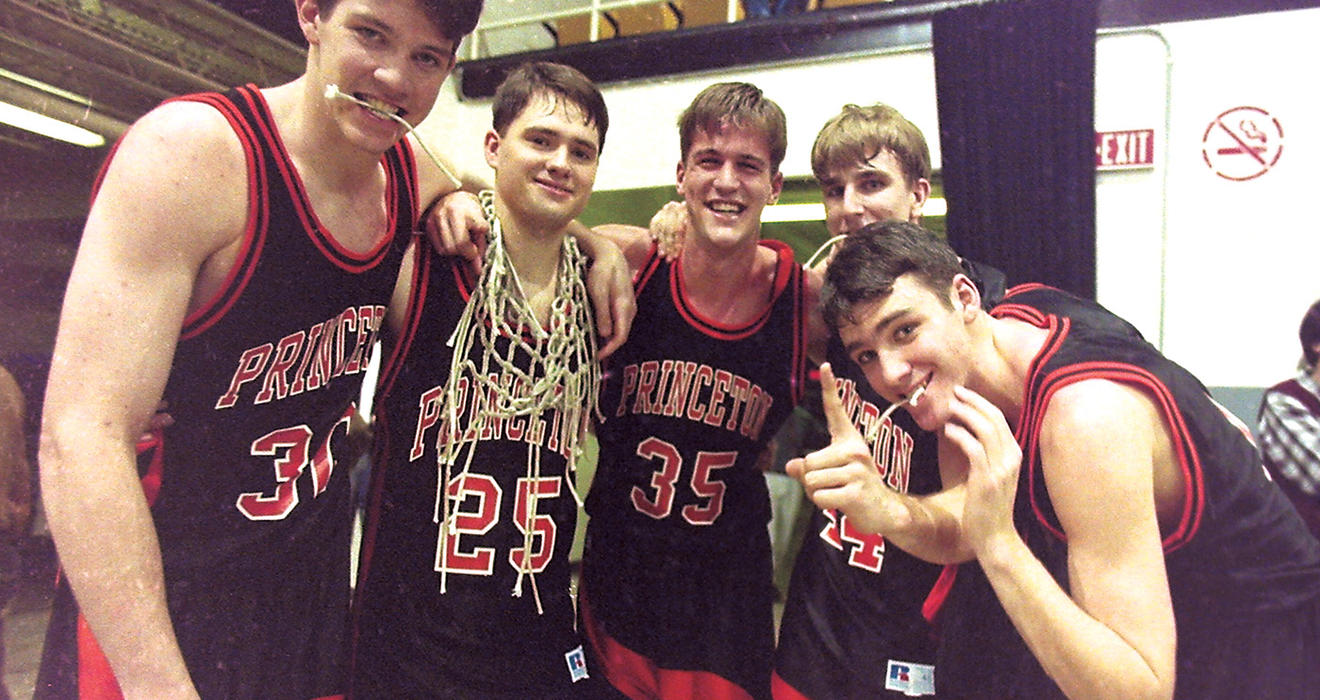
Dec. 1, 1975 — July 25, 2023
Mitch Henderson ’98 never imagined giving away this tie — orange and black, striped, at least a century old — here, at a summer afternoon funeral lunch, to the children of a teammate gone too soon. But when the former Princeton men’s basketball captain and current head coach was asked to pay tribute to James Mastaglio ’98, who died on July 25 at 47 after a brief battle with an aggressive cancer, he thought of this memento.
Another basketball alum, Chris Thomforde ’69, had received the tie from a member of the Class of 1923; soon after Henderson was named Princeton head coach in 2011, Thomforde bequeathed it to Henderson and suggested he pass it along to someone who was special to him, when the time was right.
Tragically, the time was now. “James was everything you wanted to be,” Henderson had said after Mastaglio’s death. So at the lunch commemorating the life of “Stags,” Henderson presented Mastaglio’s two children, Olivia, 11, and Kellen, 8, with the orange and black tie. It was something to remind them of the mark Mastaglio made at Princeton and beyond.
Stags, who grew up on Long Island in the town of Garden City, New York, arrived on campus in the fall of 1994, having turned down a scholarship to play basketball at Hofstra University near his home to suit up for Pete Carril and the Tigers. He started from the get-go his freshman year, scoring 13 points in his first game, against LaSalle. That output stood as a record for a Tigers freshman in his first game for the next 14 years. The Princeton office of athletic communications noted, in the pronunciation guide to Mastaglio’s name: “The G Is Silent. But There’s Plenty of O.”
With Mastaglio playing a key role, Princeton would earn Ivy League titles the next three seasons and win two NCAA Tournament games, over UCLA in 1996 and UNLV in 1998. Mastaglio used his long arms to defend the other team’s best player. In his senior year, Mastaglio started for a 26-1 team that was the story in college basketball, as the Tigers rose into the top 10. ESPN analyst Dick Vitale, the voice of college basketball in that era, named him to his “All-Blender Team.” These were the role players who, in Vitale’s view, made the biggest under-the-radar contribution to the best teams in the country.
Off the court, Mastaglio, a politics major, developed a reputation at Princeton for generosity and good company. He tooled around campus in a 1989 beige station wagon, always up for a late-night ride to Denny’s or Wendy’s. When his mom brought down her baked ziti from Long Island, James shared it with the dorm. He devoured blocks of mozzarella cheese and chicken wings but somehow remained one of the most athletic players on the team. “He was always so malleable, so flexible,” says Nathan Walton ’01, another teammate. “Nobody was ever worried about, ‘Hey, what does Stags want to do?’ He was up for anything. He was always just there. And in our circle of friends, for the rest of our lives, he’s just not going to be there. That’s just rough. There’s no silver lining there.”
After college, Mastaglio worked in the financial services industry and indulged a lifelong passion for golf course design, transforming the look and character of his local club. He coached Olivia and Kellen on a million different sports teams. During the pandemic, he’d run impromptu outdoor basketball clinics near his home, just to give the kids something to do. Before Princeton’s Nov. 10 game at Hofstra, family friend Darren Hite ’98 brought Olivia and Kellen into the Tigers locker room to meet the players. Hofstra recognized Stags with a moment of silence. The Tigers won. Small consolation, for an unfathomable loss.
Sean Gregory ’98 spent four years as Mastaglio’s basketball teammate. He is a senior sports correspondent at TIME.






No responses yet